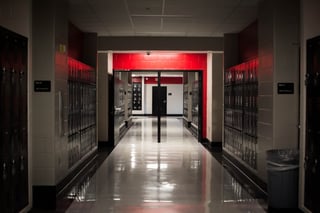School Security Systems: What's Now and What's Next?
 Protecting American schools calls for the most effective and advanced security systems on the market. Understanding which technologies are currently available, and which are on the horizon can help school security professionals plan effectively.
Protecting American schools calls for the most effective and advanced security systems on the market. Understanding which technologies are currently available, and which are on the horizon can help school security professionals plan effectively.
According to The Washington Post, there has been an average of ten school shootings per year since 1999. With disagreement throughout our political system as to the best measures to take to protect students, it’s up to school administrators, teachers, parents, and students themselves to evaluate what our academic institutions need to do to stay safe.
Designing a security system that can meet today’s challenges is paramount, but stakeholders will also want to be certain that their investments today will be worth it tomorrow. That’s why it’s so important to take up-and-coming technologies into consideration. Whether your school district wants to ensure that its existing security system is up to the task of preventing the next national tragedy or you’re beginning to build a technological security infrastructure from the ground up, it’s essential to understand what capabilities are available to you now and how they can support and integrate with the security technology of the future.
What Kinds of School Security Systems Are Being Deployed Today?
In “A Comprehensive Report on School Safety Technology” from the Department of Justice, experts indicate that 98.6% of schools use some kind of security technology to keep their students, faculty, and staff safe. Although that response is promising, the exact makeup of school security systems vary widely from one district to the next.
Typically, today’s school security systems are comprised of interdependent technologies that offer school administrators, security professionals, local law enforcement, and teachers the options they need to respond appropriately in the event of an emergency. According to the “Electronic Security Guidelines for Schools” from the Electronic Security Association, these subsystems typically include access control, surveillance technology, monitoring and supervision capabilities, intrusion detection, personal panic buttons, mechanical security hardware, lighting and special detectors, and appropriate signage.
Information from the National Center for Education Statistics shows that most public schools have some combination of these discrete capabilities in place. According to their research, 89.6% of high school security systems include controlled access to their building during school hours and 94.2% have security cameras monitoring the premises. While the remaining statistics primarily concern protocol rather than technology, these numbers make it clear that administrators are beginning to invest in the hardware they need to keep their schools safe.
What’s Next for School Security Systems
While these technologies are an important step in the right direction, emerging capabilities in the school security sector should be top of mind for stakeholders. Whatever your budget and specific needs, a number of advances in school security technology promise to make schools even safer.
Artificial intelligence (AI) will likely play a major role in next-generation school security systems. Avigilon, for example, already offers AI hardware with self-learning video analytics and “appearance search technology” which leverages AI to interpret video feeds from off-the-shelf surveillance cameras in order to identify suspicious activities and alert school administrators to potential threats.
Similarly, new gunshot detection systems are helping school administrators and law enforcement respond to active shooter scenarios faster and with better situational insight. Shooter Detection Systems (SDS) markets hardware that uses acoustic microphones and infrared sensors to distinguish gunshots from other loud noises, such as a student dropping school books or lockers slamming shut. When they’re connected with a school’s main security system, SDS’s detectors can trigger alerts which notify authorities as to the location of the shooter and the caliber of their weapon.
A handful of schools across the country offer a glimpse into the future of high school security systems. Fulton County Schools in Fulton County, Georgia for example, have deployed cutting-edge school security systems that can initiate an impressive infrastructure of security measures. On top of comprehensive security policy reform, Fulton County Schools have installed AI-enabled security cameras that enable “Fulton's operators to click on a button and search for all instances of a person or vehicle across all cameras on a site, quickly and efficiently.”
How TTI Can Help Improve School Security
Developing a new school security system can be a challenge, especially when you consider how many students, faculty, and staff you’re hoping to protect, but choosing the best solution(s) is a must. From dependable standbys such as security cameras to the most advanced AI facial recognition technology, a lot goes into creating the right security system for your school.
With TTI’s Guardian duress alarm, you’ll be adding industry-leading, future-proof technology to your school security system. As an on-site wireless Personal Security and Emergency Notification System, the Guardian allows individual faculty and staff to trigger an alarm that will alert key decision-makers to emergency situations. Once pressed, the alarm signals the user’s identity and location, and alerts them when help is on the way.
Because of its unique discrete capabilities and easy integration, Guardian systems will remain cutting-edge far into the future. For school administrators tasked with selecting the key pieces of their security system, TTI has the solutions to help and the expertise to contribute to an advanced suite of life-saving technologies.
About Tony Ridzyowski
Tony Ridzyowski leads the Inside Sales Team at Turn-key Technologies, Inc., where he also supports marketing, partner strategy, training, and CRM operations. Since joining TTI in 2014, Tony has earned top producer honors and President’s Club recognition. With a background in network cabling and experience working with Fortune 500 clients like Wells Fargo and Countrywide Home Loans, Tony brings decades of industry insight to every customer conversation.





